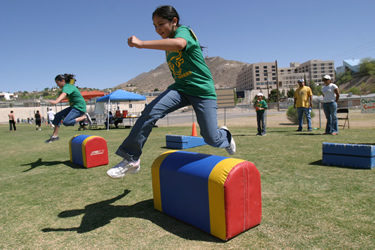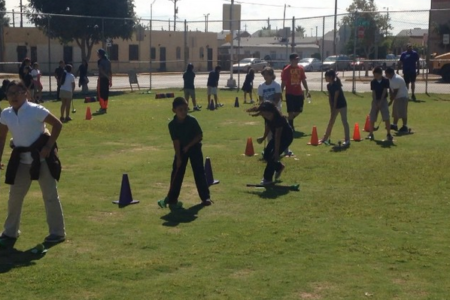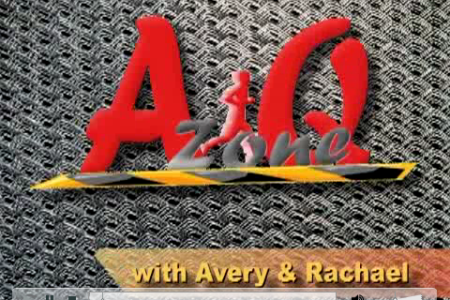Share On Social!
In the predominantly Latino city of El Paso, Texas, kids are priority No. 1 thanks to a community-school partnership that prioritizes physical activity and health for children. The El Paso Independent School District (EPISD) created and its Get HIP Now program to provide elementary- and middle-school students with integrated school health programming, alongside before- and after-school physical activity.
EMERGENCE
Awareness: As early as 2005, leaders at the El Paso Independent School District (EPISD), an 83% Latino school district in El Paso, Texas, were becoming aware of student obesity issues.

It seemed obvious that students could benefit from improvements to physical activity programing, according to John Adams, a P.E. instructor at the time who would eventually become the EPISD director of health, wellness and physical education.
But more fitness wasn’t a common thought at the time.
“Back in the 80s and 90s, we started seeing school districts eliminate P.E.,” Adams said. “I don’t know if there was a direct correlate, but just a few years later we saw a spike in these obesity rates.”
Adrian Flores, a longtime P.E. coach at EPISD’s Aoy Elementary School, had similar fitness concerns and also noticed cultural barriers to healthy eating.
“The old mind set was, ‘The more a kid eats, the healthier they’re going to be,’” Flores said.
Learn: Fortunately, along with Adams and Flores, district leaders were similarly concerned.

In 2005, the district hired Don Disney to fill a new position—director of health, wellness and P.E. Disney worked with many district officials and helped launch new health and wellness programs to tackle health literacy and physical activity, too, Adams said.
“[Don Disney] was really a visionary and he started to turn things around,” Adams said. “He said we need start looking at the whole child.”
Frame Issue: The district wanted to identify several areas where it could improve.
They assessed the district’s two-year-old coordinated school health (CSH) program utilizing the U.S. Center for Disease Control and Prevention’s (CDC) School Health Index (SHI) tool to help determine areas where school health policy could be strengthened. A CSH program consists of 8 interrelated components designed to create a healthy school environment. The eight components consist of: comprehensive school health education, family & community involvement, school-site health promotion for staff, health school environment, counseling psychological & social services, nutrition services, school health services, and physical education.
The good news?

About 80% of students were getting moderate-to-vigorous physical activity (MVPA) during recess.
The bad news?
Only 8% of faculty received state-mandated CSH training. Less than 20% of school campuses offered before- and after-school physical activity programming. Fewer than 40% of elementary students got weekly or monthly health education.
They found most teachers want to teach health lessons, but don’t have much time given the time they spend on subjects like math and reading.
They wanted to build a true coordinated school health curriculum—with health literacy concepts embedded in all other lessons and more physical activity.
“Mr. Disney and his team decided that they were going to venture out and create a district specific health curriculum that’s tied to the content areas (i.e. math, reading, science),” Adams said. “That was very, very innovative because now you’re not just asking a teacher to teach health, you’re asking them to teach the health concept in a way that already fits into their curriculum.”
DEVELOPMENT

Education/Mobilization: In 2009, just a year after the initial assessment, EPISD officials applied for and received $2.8 million from the Paso del Norte Health Foundation (Paso Del Norte) to overhaul the district’s curriculum, health, P.E. and coordinated school health program.
The district hired new curriculum specialists and started a team of its own teachers as curriculum advisors, including Flores.
The team would lead creation create a health curriculum, called the Get Health Initiative Program (HIP) Now, Get HIP Now.
The idea was to develop a leadership structure that would allow for improvement and sustainability at the school level.
“They started from scratch,” Adams said. “They had to create the resources, the handbook, and they put it in the district’s [intranet] system.”
Debate: Would teachers buy in to such a curriculum?
To make sure, the team involved teachers in the curriculum development process, so they would be more willing to incorporate health concepts into their lesson, Adams said.
“We came together and we designed the curriculum to help new teachers and also old teachers get involved in teaching health,” Flores said.
ENACTMENT

Activation: Get HIP Now also aimed to boost physical activity beyond just sports-based programs.
They envisioned developing activity quotient (AQ) zones for elementary schools and wellness centers for middle schools.
“Activity zones get kids up and moving before and after school,” Flores said.
AQ zones are designed to be less structured that PE and more structured that recess. They also give students the opportunity to participate in:
- Group and team games (soccer, basketball, & tennis drills)
- Individual activities (i.e. hula hoops and jump rope); and
- Walking and jogging
Similar to AQ zones, wellness centers or fitness-based labs would provide middle-school students with supervision and a place to go before or after school to exercise.
Frame Policy: Through the Get HIP Now program, the district aimed to address students’ social, physical and mental health needs.
Ultimately the program’s goals for students (and their families) were to:
1) Increase health literacy;
2) Increase physical activity; and
3) Create systemic change.

The Get HIP Now CSH curriculum would include three-week-long modules, or lessons complete with a health goal, classroom based activities, home based activities and resources to help teachers prepare lessons that incorporate help into weekly lessons in math, science, language arts and social studies.
The twelve modules taught as part of the Get HIP Now curriculum include:
- Total health
- Balanced diet
- Food choices
- Wise decisions
- Family and friends
- Violence and injury
- Sun Safety
- Staying Well
- Physical activity
- Safety at home and school
- Personal hygiene
- Basic nutritional needs

In creating each of these themes, the district made sure that they aligned well with CDC’s 8 components of CSH and the Texas Essential Knowledge and Skills (TEKS) (state standards for each subject taught).
In order to bring more before and after school programming to students, teachers who agreed to lead AQ zones and health and wellness centers would initially be paid a stipend. Additionally, a wellness team captain at each school would also be paid a stipend to promote wellness activities among faculty and students throughout the school year.
Change: By fall 2010, EPISD gave all teachers online access to GET HIP Now curriculum and materials through the district’s private intranet system.
“Now kids are getting that instruction time for health,” Adams said.
Wellness centers with equipment like stationary bikes, weights, and fitness balls were established at all EPISD middle schools, and designated teachers at elementary schools led before- and after-school activities through AQ zones.
In P.E., teachers provide up to 50% of daily MVPA to students by using the Get HIP Now curriculum and sometimes adding their own new twist to fitness activities. At the end of a three-week module, classroom teachers send home bilingual materials to provide parents with ideas for healthy activities that they can do at home with their children.
The district also started encouraging teachers to implement 2-3 minute short activity breaks (brain breaks) throughout the day. They even created videos that explain why brain breaks are important and provided teachers with a link on the district’s internal site with examples of brain breaks.
IMPLEMENTATION

Implementation/Equity: While the district sets dates as to what should be taught each week, schools and teachers still have some flexibility as to how they wish to implement lessons.
“We didn’t want to take away creativity from the coach,” Flores said. “If they have a better game, they can teach that as well as long as it follows the TEKS.”
According to Flores, with the Get HIP Now CSH approach, everyone from cafeteria personnel to guidance counselors is a key player in promoting health among students.
“Cafeteria staff also has announcements they make,” said Flores.
According to Flores, they’ll say something like “today we’re eating broccoli which is delicious and gives you what you need to be healthy and strong.”
Guidance counselors also play a role in GET HIP Now by supporting healthy behaviors and wise decisions.
The days and times at which AQ zones and wellness centers operate vary from school to school. At Aoy Elementary School, for instance, Flores says they start out with a two-week unit on basic conditioning, then students are introduced to four weeks of gymnastics through the “tumble weeds” unit. After this, kids are taught tennis skills through the “heads up” lesson.
At some schools, like Horneado Middle School, teachers lead by example by using the school’s wellness centers after school and encouraging student use.
“It’s [students’] facilities, if they chose to share with the teachers that’s great,” Adams said.
Sustainability: Although the Get HIP Now grant has since expired, its curriculum and programming continue at EPISD schools. At the end of the school year, the district still looks to teachers to help keep the Get HIP Now curriculum current and in line with the state’s TEKS.
“[The district’s teachers] come in and revise our curriculum according to what the changes were,” Adams said. “We’re now working to enhance the curriculum with yoga.”
By The Numbers
84
percent
of Latino parents support public funding for afterschool programs
This success story was produced by Salud America! with support from the Robert Wood Johnson Foundation.
The stories are intended for educational and informative purposes. References to specific policymakers, individuals, schools, policies, or companies have been included solely to advance these purposes and do not constitute an endorsement, sponsorship, or recommendation. Stories are based on and told by real community members and are the opinions and views of the individuals whose stories are told. Organization and activities described were not supported by Salud America! or the Robert Wood Johnson Foundation and do not necessarily represent the views of Salud America! or the Robert Wood Johnson Foundation.



